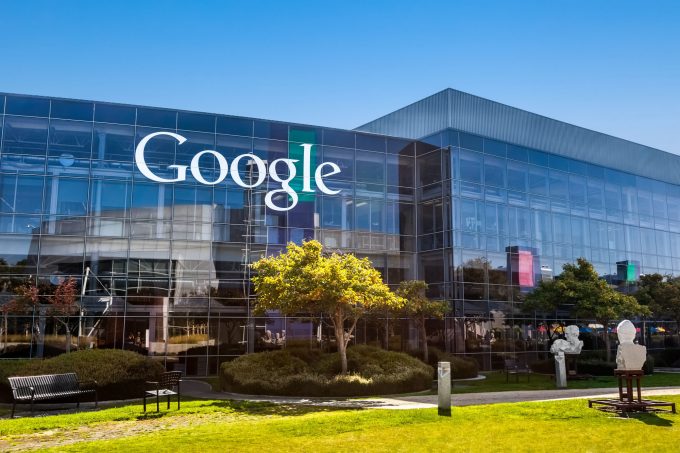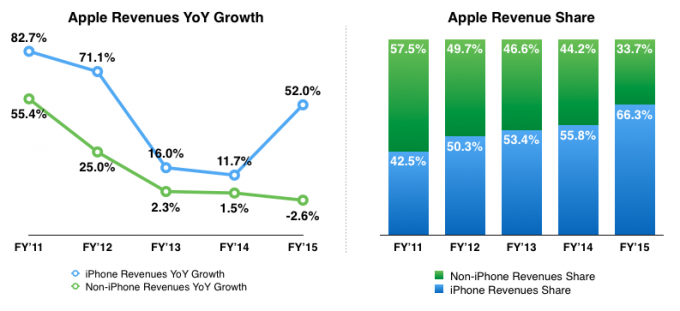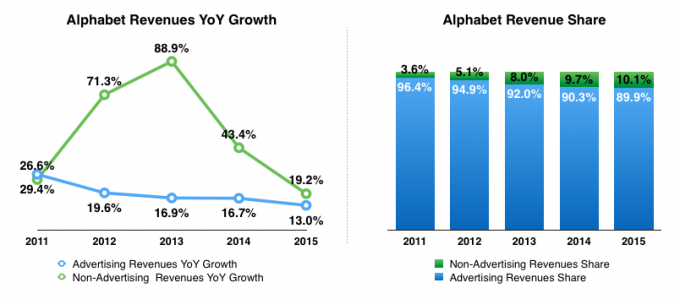On Tuesday, February 2, 2016, when the markets opened, Alphabet (parent company of Google) became the most valuable company in the world replacing Apple. At the market opening, Alphabet market cap reached $547 billion, whereas Apple market cap was $529 billion. Why do investors believe that Alphabet is more valuable than Apple? Before we try to debate that, let us compare Alphabet revenues, profits, and profit margins with that of Apple for the last 5 years.
Apple Revenues, Profits, and Profits Margins from 2011 to 2015
Apple generated $234 billion of revenues in FY 2015 (fiscal year ending September 2015). Apple’s total net profit in FY 2015 was $53 billion. This resulted in a net profit margin of 22.8%.
Alphabet Revenues, Profits, and Profit Margins from 2011 to 2015
Alphabet generated $75 billion of revenues in 2015 (year ending December 2015). Alphabet net profit in 2015 was $16 billion. This resulted in a net profit margin of 21.8%.
Why Alphabet is more valuable than Apple?
As we can see from the charts above, Apple has over three-times more revenues and profits than Alphabet. The profit margins of both companies are also similar. Then, why do investors think that Alphabet is more valuable than Apple? What are some possible arguments?
1. The revenue growth rates
The first argument is that Apple’s growth rate will slow down because the best iPhone sales are behind us. iPhone is the major source of revenues and profits for Apple. In FY 2015 (fiscal year ending September 2015), Apple generated 66% of its total revenues from the iPhone. Since iPhone sales might decline in the future, it may impact Apple’s overall revenues and profits. This concern may appear true when we look at Apple’s non-iPhone revenues growth.
If we look at the Alphabet’s advertising vs non-advertising revenues growth, they are also slowing down. But, investors seem to worry less about that.
Let us compare the revenues year-over-year growth of Alphabet and Apple. In FY 2010, Apple revenues were $65 billion. This is almost similar to the Alphabet’s revenues of $66 billion in 2014. Now, Apple grew at 66% and 45% in FY 2011 and FY 2012 respectively. On the other hand, the Alphabet’s total revenues grew by 14% in 2015. This is far lower growth than that of Apple. Even over the next two years, in 2016 and 2017, the consensus estimates for Alphabet’s YoY growth are 14-15%. It may take Alphabet 5-10 years to reach the current revenues and profits of Apple.
2. The competitive edge
Investors believe that Google has a strong competitive position. Google has a dominant position in the search advertising market. As the global online population increases, the search activity will increase. Also, more online businesses will increasingly use search and display advertising to reach out to their target users. As for Apple, the argument is that the smartphone market is turning extremely competitive. Google’s Android-based smartphones are also giving a big challenge to Apple iPhone.
We believe that both companies have built a sustainable competitive advantage for themselves. It is difficult to give more points to one over the other.
Apple has also built a sustainable competitive advantage with its vertically integrated model, strong network effects with its platforms for content and apps distribution, and its own retail store’s strategy. (See ‘How Apple Makes Money?’ for details.)
3. The growth potential and investor visibility

Investors are getting increasingly impatient about yet another disruptive product from Apple. Since Apple works secretly on most of its products and announces them only when they are ready for launch, Investors have a little clue on what great product might be coming up next. So, they are unable to estimate the growth potential of Apple’s upcoming products.
On the contrary, Investors have some idea about the different future revenue sources of Alphabet. These include Access/Google Fiber, Calico, Nest, Verily (formerly Google Life Sciences), GV (formerly Google Ventures), Google Capital, X (formerly Google X) and other initiatives. They know Alphabet is currently losing most of the money on these bets right now. In 2015, Alphabet earned less-than-half-a-billion dollars of revenues from the non-Google companies but had losses of three-and-half-billion dollars from those companies.
But, investors seem to care less about the losses. They are more happy about the fact that they have more visibility into where the company is losing money. We think it is the investor visibility aspect where Apple is losing out to Alphabet.

Important Notes Regarding The Charts
- In all of the charts above, the revenues, profits, and profit margin numbers correspond to the fiscal years of the companies. Alphabet’s fiscal year ends in December. Apple’s fiscal year ends in September.
- Even though Alphabet numbers are for the December-ending fiscal year and Apple numbers are for the September-ending fiscal year, we can still make a comparison between them for the purposes of this post. Making adjustments for one-quarter of the revenues of either company won’t impact the overall message. The fiscal year numbers are chosen for comparison because they are readily available and most people can easily relate to these numbers.














